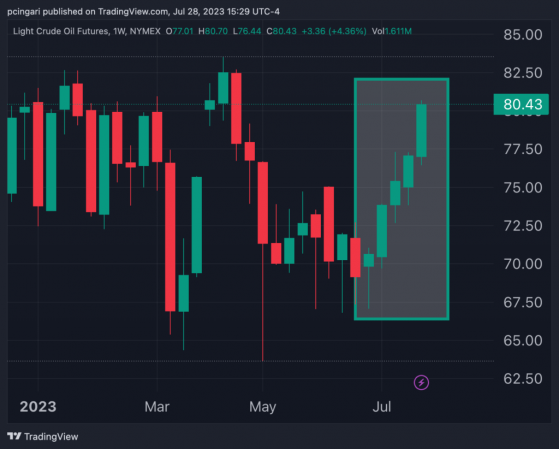Benzinga - Crude oil has gained five weeks in a row, almost undetected by investors who are completely focused on the stock market surge fueled by AI stocks and the significant reduction in inflation.
Such a winning stretch has not occurred in the oil market in over a year and a half, with the most recent instance being eight weeks of advances between December 2021 and February 2022.
On Friday, the West Texas Intermediate (WTI) crude oil surpassed the $80-per-barrel milestone, reaching levels not seen since April 19, 2023.
After falling as much as 45% between mid-June 2022 and mid-June 2023, oil prices have rebounded strongly this month.
Crude has risen by 14% month to date, currently boasting the second-best monthly performance in 2023, only behind January’s 16%, with one more session to go.
Chart: WTI Prices Mark Fifth Week Of Gains In A Row, Rising Above $80 A Barrel
Why Is Oil Rising?
Oil prices have risen significantly as a result of a number of variables affecting both supply and demand.On the supply side, Saudi Arabia and Russia have made efforts to reduce output, causing oil supplies to tighten. Furthermore, OPEC+ has indicated its willingness to take additional initiatives to assist the oil market.
On the demand side, Chinese officials have pledged to revive its lagging economy, raising hopes for a spike in domestic petroleum consumption. The U.S. has also pledged to buy Strategic Petroleum Reserve to refill stocks at over 40-year lows.
Read Now: Stocks Surge, Tech Rallies On Strong Earnings, Inflation Softens: What’s Driving Markets Friday?
5 Oil-Linked ETFs To Track Crude Gains
- United States Oil Fund (NYSE:USO)
– Description: The United States Oil Fund ETF seeks to track the price movements of WTI crude oil, providing investors with direct exposure to the oil market without the complexity of owning a physical barrel.
- Energy Select Sector SPDR Fund (NYSE:XLE)
– Description: The Energy Select Sector SPDR Fund ETF seeks to replicate the performance of the energy sector in the S&P 500 Index. It holds major U.S. energy corporations involved in a variety of operations such as oil and gas exploration, production, refining and distribution.
– Major holdings: Exxon Mobil Corp. (NYSE:XOM), 21.2%; Chevron Corporation (NYSE:CVX), 18.5%.
– Total return (%) year to date: -1.4%
– Total return (%) last month: 8.6%
- VanEck Oil Services ETF (NYSE:OIH)
– Description: The VanEck Oil Services ETF, which targets oil services companies, invests in companies that provide drilling, equipment, and support services to the oil sector. It may profit from increased oil sector activity and demand.
– Major holdings: Schlumberger N.V. (NYSE:SLB), 19.9%; Halliburton Company (NYSE:HAL),11.1%; Baker Hughes Co. (NYSE:BKR), 8.8%.
- Proshares Ultra Bloomberg Crude Oil (NYSE:UCO)
– Description: Proshares Ultra Bloomberg Crude Oil is a leveraged ETF that seeks to track the Bloomberg WTI Crude Oil Subindex by providing twice the daily return. It is appropriate for investors seeking increased exposure to crude oil price swings, but it is riskier due to its leverage.
- Direxion Daily S&P Oil & Gas Exp. & Prod. Bull X2 Shares (NYSE:GUSH)
– Description: The Direxion Daily S&P Oil & Gas Exp. & Prod. Bull X2 Shares ETF, which is leveraged at twice the daily return of the S&P Oil & Gas Exploration & Production Select Industry Index, is intended for investors who want a boost in their exposure to the oil and gas exploration industry.
Photo: Shutterstock
Read the original article on Benzinga
